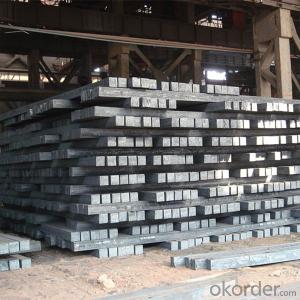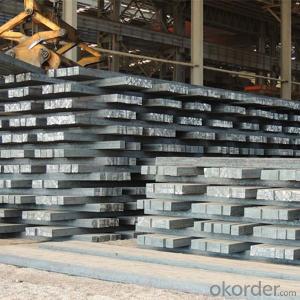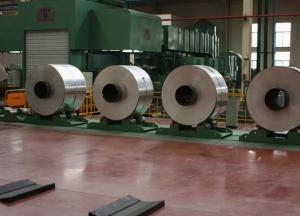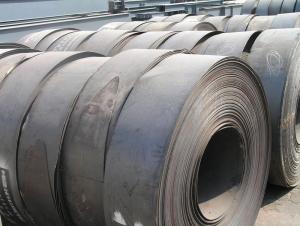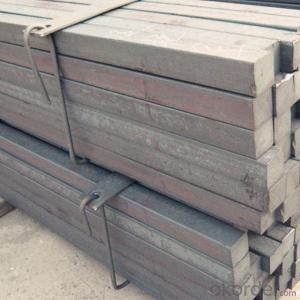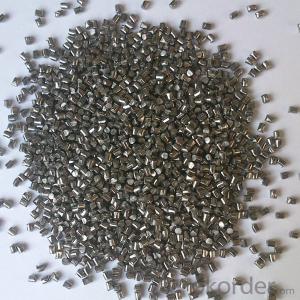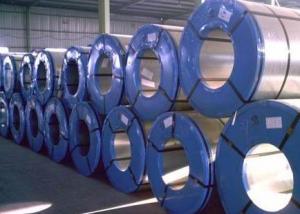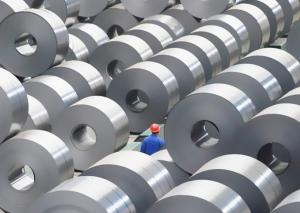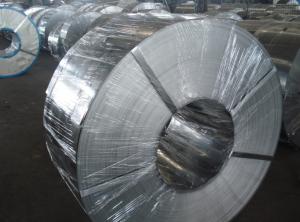Steel Billet Made in China/ China Supplier
- Loading Port:
- China main port
- Payment Terms:
- TT OR LC
- Min Order Qty:
- 1000 m.t.
- Supply Capability:
- 100000 m.t./month
OKorder Service Pledge
OKorder Financial Service
You Might Also Like
Item specifice
Specifications:
Type | Steel billet / Square steel/ Steel square bar |
Standard grade | 3SP/PS, 5SP/PS, Q195, Q235, Q255, Q275, 20MnSi etc. |
MOQ | 1000 MT |
Technique | Hot rolled, Continuous casting and rolling |
Size | 50*50mm ~ 160*160mm |
Length | 3~12m |
Packing | Loose packing, in bundle |
Payment terms | T/T, L/C at sight, Usance L/C |
Trade terms | EXW, FOB, CFR, CIF |
Trans terms | FIO, FILO, FLT |
Inspection | Third party inspection accepted |
Delivery time | 15-30 days, according to the quantity |
Applications | carbon structural steel, wire rod, rod, deformed bars, profile steel, machine parts, and steel moulds etc . |
Note | Customized service is available (for sizes,length and chemical components etc.). |
Steel Grade:
Steel Grade | C % | Mn % | Si % | S % | P % |
Q195 | 0.06-0.12 | 0.25-0.50 | 0.30 Max | 0.04 Max. | 0.04 Max. |
Q235 | 0.12-0.22 | 0.30-0.60 | 0.30 Max. | 0.04 Max. | 0.04 Max. |
Q255 | 0.18-0.28 | 0.40-0.70 | 0.30 Max. | 0.045 Max. | 0.050 Max. |
Q275 | 0.27-0.38 | 0.50-0.80 | 0.30 Max. | 0.045 Max. | 0.045 Max. |
3SP | 0.14-0.22 | 0.40-0.85 | 0.15-0.30 | 0.050 Max. | 0.040 Max. |
5SP | 0.28-0.37 | 0.50-1.00 | 0.15-0.30 | 0.050 Max. | 0.040 Max. |
20MnSi | 0.17-0.25 | 1.00-1.60 | 0.40-0.80 | 0.050 Max. | 0.050 Max. |
Products Picture:

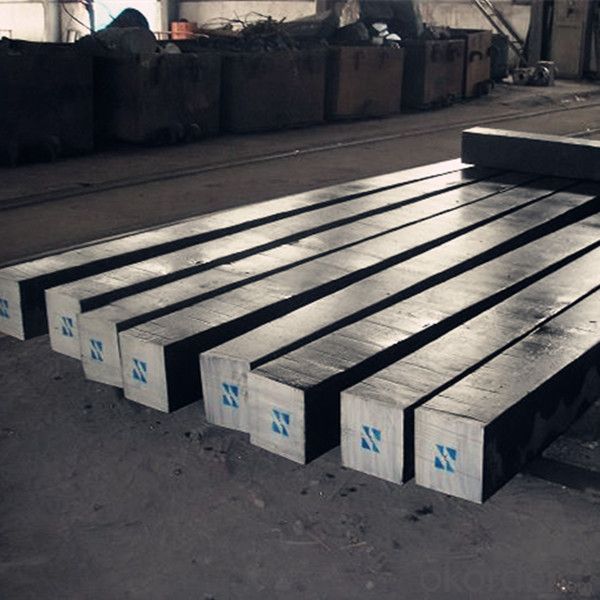
FAQ
Q: Can I get sample and how long will it take?
A:Yes. We can supply sample. And you need to pay for courier.
Q: What's the MOQ?
A: Our MOQ is 25mt.
Q: What's the delivery time?
A: It will take about 30 days after TT or L/C.
Q: What is the payment terms?
A: T/T, L/C at sight
Q: How does your factory carry out quality control?
A: We attach great importance to quality control.Every part of our products has its own QC.
Q: What certificate do you have?
A: We have SGS, ISO9001 etc. Also we can apply any certificate if you need if the qty is OK.
- Q:How does steel sheet metal cutting and punching work?
- Steel sheet metal cutting and punching typically involve using specialized machinery, such as lasers, plasma cutters, or mechanical presses, to cut or punch holes in steel sheet metal. The process begins with the metal sheet being secured onto a flat surface or within the machine. The cutting or punching tool is then guided across the sheet, applying focused force or energy to remove material and create the desired shape or hole. This process can be precise and efficient, allowing for the fabrication of various steel components used in industries like construction, automotive, and manufacturing.
- Q:What are the applications of steel wire mesh in marine environments?
- Steel wire mesh has various applications in marine environments due to its durability and corrosion resistance. It is commonly used for marine structures such as breakwaters, seawalls, and jetties to provide stability and prevent erosion. Steel wire mesh is also utilized in fish farming to create cages and nets for fish containment and protection. Additionally, it is employed in marine construction projects for reinforcement and support in concrete structures, ensuring their longevity and strength in harsh saltwater conditions.
- Q:How are steel beams used in building structures?
- Steel beams are used in building structures as load-bearing elements that provide strength and stability. They are commonly used in the construction industry due to their high strength-to-weight ratio, allowing for the creation of large, open spaces without the need for excessive columns or supports. Steel beams distribute weight evenly, helping to support the weight of floors, walls, and roofs, and can withstand significant forces, such as wind and earthquakes. They are essential in constructing high-rise buildings, bridges, and industrial structures, where durability and structural integrity are paramount.
- Q:What are the properties of heat-resistant steel for high-temperature applications?
- Heat-resistant steel for high-temperature applications possesses several distinctive properties. Firstly, it exhibits excellent stability and retains its strength even at elevated temperatures, allowing it to withstand thermal stress without deformation or failure. Additionally, it has a high melting point, ensuring it remains structurally intact under extreme heat conditions. Another essential property is its resistance to oxidation and corrosion, preventing the formation of detrimental oxides or degradation due to chemical reactions. Moreover, heat-resistant steel often has low thermal expansion, meaning it expands minimally when exposed to heat, reducing the risk of dimensional changes and maintaining its mechanical integrity. Overall, these properties make heat-resistant steel a reliable and durable choice for applications requiring the handling of high temperatures.
- Q:How do steel products contribute to the construction of research laboratories and scientific facilities?
- Steel products play a crucial role in the construction of research laboratories and scientific facilities. They provide structural support and durability, ensuring the safety and integrity of the buildings. Steel beams, columns, and frames are commonly used to create large open spaces, allowing for flexible layouts and accommodating various equipment and machinery. Additionally, steel is resistant to fire, corrosion, and pests, making it an ideal choice for laboratories where hazardous materials and sensitive experiments are conducted. Overall, steel products are essential components in creating efficient, functional, and secure research facilities.
- Q:How is steel used in the construction of convention centers and exhibition halls?
- Steel is commonly used in the construction of convention centers and exhibition halls due to its strength and versatility. It is used to create the structural framework and support systems, including columns, beams, and trusses. Steel's high strength-to-weight ratio allows for spacious, open interiors without the need for excessive supporting columns. Additionally, its durability and resistance to fire and corrosion make it an ideal choice for these large-scale structures, ensuring long-term stability and safety.
- Q:How do steel products contribute to the construction and infrastructure development sector?
- Steel products are crucial to the construction and infrastructure development sector due to their strength, durability, and versatility. They are used in a wide range of applications such as beams, columns, and reinforcements, providing structural integrity to buildings and bridges. Steel's high strength-to-weight ratio allows for the creation of lightweight structures that can withstand heavy loads, making it ideal for constructing tall buildings and long-span bridges. Additionally, steel's resistance to corrosion ensures the longevity of structures in various environments. Overall, steel products play a vital role in the construction and infrastructure development sector by providing reliable and sustainable solutions.
- Q:What are the common types of steel products used in the e-commerce and logistics industry?
- Some common types of steel products used in the e-commerce and logistics industry include steel pallets, steel storage racks, steel shipping containers, steel shelving units, and steel security cages.
- Q:How is steel plate produced?
- Steel plates are produced through a process called steelmaking, where iron ore is melted in a blast furnace along with other elements like limestone and coke. This molten iron is then refined and converted into steel by removing impurities through various methods such as oxygen blowing or electric arc furnaces. The steel is then cast into slabs or billets, which are further rolled into desired thicknesses and shapes to produce steel plates.
- Q:How does steel pipe coating for marine applications work?
- Steel pipe coating for marine applications works by applying a protective layer of coating to the surface of the steel pipe to prevent corrosion and extend its lifespan. The coating acts as a barrier against harsh marine environments, preventing the pipe from being exposed to corrosive elements such as saltwater and chemicals. This coating can be achieved through various methods such as fusion bonded epoxy (FBE), polyethylene (PE), or polypropylene (PP) coatings. These coatings provide excellent adhesion to the steel surface, ensuring long-term protection against corrosion, abrasion, and mechanical damage. Additionally, the coating also enhances the pipe's resistance to UV radiation and provides insulation against temperature fluctuations.
1. Manufacturer Overview |
|
|---|---|
| Location | |
| Year Established | |
| Annual Output Value | |
| Main Markets | |
| Company Certifications | |
2. Manufacturer Certificates |
|
|---|---|
| a) Certification Name | |
| Range | |
| Reference | |
| Validity Period | |
3. Manufacturer Capability |
|
|---|---|
| a)Trade Capacity | |
| Nearest Port | |
| Export Percentage | |
| No.of Employees in Trade Department | |
| Language Spoken: | |
| b)Factory Information | |
| Factory Size: | |
| No. of Production Lines | |
| Contract Manufacturing | |
| Product Price Range | |
Send your message to us
Steel Billet Made in China/ China Supplier
- Loading Port:
- China main port
- Payment Terms:
- TT OR LC
- Min Order Qty:
- 1000 m.t.
- Supply Capability:
- 100000 m.t./month
OKorder Service Pledge
OKorder Financial Service
Similar products
New products
Hot products
Hot Searches
Related keywords
